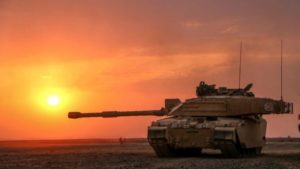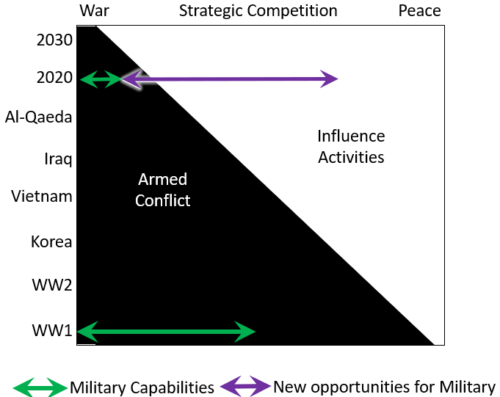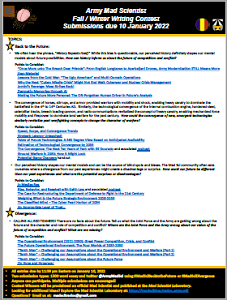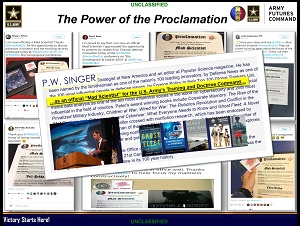A post on the forthcoming war for Information Advantage, Decision Superiority, and Cognitive Dominance
[Editor’s Note: Earlier this year, Dr. Russell Glenn‘s Sub-threshold Maneuver and the Flanking of U.S. National Security post addressed how our adversaries are seeking to shape and achieve their nefarious objectives below the threshold of kinetic conflict using cyber and information operations. As noted, countering this “sub-threshold maneuver” will require a sea change in how we organize and apply our U.S. National Security structure to deter, and failing that, directly engage our adversaries in this new era of competition, crisis, and conflict.
 Today’s provocative post by guest blogger Capt Martin Crilly, British Army, expands upon this theme to explore the challenges facing us in transforming for “post-digital hyper-war” — where kinetic engagements between exquisite, industrial age platforms may be rendered irrelevant by “more subtle, intellectual, and nuanced information, cyber, and cognitive influencing ‘soft power‘ capabilities.” While some may resist, preferring to cling to the traditional and familiar ways of warfare, “shrewd futurists see a whole host of new sunrise opportunities in the utility and application of a post-digital reimagined military, a completely redefined military equipped with a whole host of new capabilities to fight this post-digital strategic competition.” Read on to learn more about Capt Crilly’s prescription for winning the forthcoming hyper-war!]
Today’s provocative post by guest blogger Capt Martin Crilly, British Army, expands upon this theme to explore the challenges facing us in transforming for “post-digital hyper-war” — where kinetic engagements between exquisite, industrial age platforms may be rendered irrelevant by “more subtle, intellectual, and nuanced information, cyber, and cognitive influencing ‘soft power‘ capabilities.” While some may resist, preferring to cling to the traditional and familiar ways of warfare, “shrewd futurists see a whole host of new sunrise opportunities in the utility and application of a post-digital reimagined military, a completely redefined military equipped with a whole host of new capabilities to fight this post-digital strategic competition.” Read on to learn more about Capt Crilly’s prescription for winning the forthcoming hyper-war!]
Consensus on the definition of the post-digital era has yet to be found. Some suggest it is the twilight of a time when everything has become digital, a pervasive epoch, simultaneously transformative yet equally irrelevant. Others believe it should be referred to as an era of persistent connectivity with suggestions of military cloudlets accompanying troops onto the battlefield. Either way, similar to the industrial era solutions of electricity, piped gas, and water mains, this time will see digital being regarded as just another ubiquitous commodity, mundane and nothing much to marvel. It is also a time inhabited by digital natives, digital nomads, and machines where digital is just a bland homogeneous background commodity, noticed only by its absence. Similar to our understanding of electricity, gas, and water supply, we won’t marvel at this new ubiquitous commodity; it too just exists, noticed only by its absence.

Consensus on the definition of hyper-war has also yet to be found but it is coming; a hyper-scale, hyper-connected and hyper-speed global competition between these digital natives, digital nomads and these digital machines making the concept of a traditional military platform-based contest largely irrelevant. By assuming this dystopia as the baseline, it is then imperative we quickly move these sunset legacy platforms into history. In doing so, it allows us to open space to pivot our thinking up into the contemporary capability layer, not marvelling at digital per se, but focusing on how these new capabilities have already changed the inter-state, intra-state, and sub-threshold battlefields (for both us and our adversaries). We can now begin to ask far more interesting questions — Is the World Ready for this war? How would we fight/compete in this era? With who? And how will we C2 all of it to ‘win’ this post-digital hyper-war?
The challenges of the post-digital hyper-war
We are not alone in this, the post-digital phenomenon is dominating all world societies, their institutions, and peoples — irrelevant of their socio-economic status. The implications for states, government, and the C2 of future warfare are chilling. How will a weakened state, pseudo-state, or next wave of dispersed virtual youth tribe fight, compete, or exert influence during this new age of conflict? The nation-state faces a new acrimonious strategic competition using new forms of non-state violence, a war between philosophies, ideas, technologies, and economics — increasingly unlikely to be a physical kinetic conflict. The traditional hard power capabilities of industrial age kinetic power militaries are no longer relevant in this post-digital battlefield, replaced by opportunities for more subtle, intellectual and nuanced information, cyber, and cognitive influencing ‘soft power‘ capabilities (see Figure 1, below).


Some lament and fight the sunset of these legacy ‘hard power’ capabilities, but shrewd futurists see a whole host of new sunrise opportunities in the utility and application of a post-digital reimagined military, a completely redefined military equipped with a whole host of new capabilities to fight this post-digital strategic competition. In defining the next war in this context, the challenge becomes less about grafting advanced technical appendages onto lumbering iron targets but more the holistic transformation of our industrial-age physical military into a virtual, multi-dimensional, globally integrated influencing arm of the state. This new, reimagined military will then need to be equally as nimble, practised, and competent at exerting state influence in the information, cyber and cognitive dimensions as it currently is in the physical dimension.
Future Threats: Legacy institutions, ready to fight the last war?
This conundrum is not unique, it is being faced by all the world’s industrial age militaries and each is grappling with relentless upgrading of legacy platforms with iterative employment concepts every few years, e.g., JADC2, chasing the roller-coaster of seductive novel digital micro-modernisations to achieve fleeting information advantage. Large standing militaries worldwide are firmly anchored in centuries of history, rules, processes and industrial-age anachronisms, but as observed by Gen Mark Welsh, CSAF, “holding on to the things that made us great in the past is not the way to make us great in the future.”
The size of our legacy military capabilities correlates to the diminishing armed conflict ‘market’ largely being replaced by new influencing activities (see Figure 2, below), with these new capabilities being provided by other ministries, corporations, and media. Traditional Industrial era militaries are increasingly lagging behind in the transformed market for state influence, their adoption to this new reality has just been too slow; most have now missed the opportunities presented during this era and are struggling for relevance. The necessity is now to rapidly begin thinking more radically, bolder, and faster or they will also miss the post-digital era.

Recommendations
As digital increasingly pervades, metastasises and saturates our battlespaces (similar to civil society), processing data up the cognitive hierarchy into intelligence, then into understanding and options will require decisions to be now taken at unimaginable speeds (see Figure 3, below). Into that complexity is added transmission latency, data overload, and cyber security as the new battlefield constraints. The maintenance of relevancy is the commander’s new intent and being able to communicate our ideas, messages, and effects before others do will be the new mission.
We need to pause, think, and envision this hyper-war. We can assume and expect that it is going to be technically complex, involve massive amounts of data with new hyper-connectivity, multi-channel, and multi-media  transmission challenges with constant flux being the default. The human Multi-Domain Command and Control (MDC2) decider will soon be redundant, replaced and upgraded by a new AI machine. It is just impossible for a human to comprehend and process the fire-hose of data traffic in this war of Information Advantage, Decision Superiority, and Cognitive Dominance at the quantum pace needed to succeed in these engagements.
transmission challenges with constant flux being the default. The human Multi-Domain Command and Control (MDC2) decider will soon be redundant, replaced and upgraded by a new AI machine. It is just impossible for a human to comprehend and process the fire-hose of data traffic in this war of Information Advantage, Decision Superiority, and Cognitive Dominance at the quantum pace needed to succeed in these engagements.

Is the World Ready?
Yes, we are ready. But we need to stop fretting about our ability to win information advantage in the information age — it is too low down the value chain and that time has passed. We are actually well ahead of our competition in the post-digital age: The early use of AI enabled decision support, machine learning, and our #1 top-secret weapon — our young Soldiers and officers — mean that a lot of the basics are already in place.
But some resistors are holding back the change:
1. Our Thinking: Our reluctance to let go of old, outdated industrial-age doctrine, TTPs, thinking, and our sentiment for legacy sunset platforms is stymieing progress, sapping our energy, and slowing us down. I’m part of the problem — I thought we could architect the Information Age war, but I’m now worried if this is also too late or dated guidance.
2. Our Leadership: We need to decide who is going to lead this hyper-war. Lt Gen Michael S. Groen, Director, Joint Artificial Intelligence Center (JAIC) says “How we want to fight in the future is a question for warfighters… not IT people” and in a future IT-enabled traditional physical, industrial-age battle, he is probably correct. In a post-digital hyper-war where intellect, media-savvy, and digital competence will deliver decision superiority and cognitive dominance, then leadership traits might favour those with more intellectual nuanced demeanours.
3. Our Harnessing of Talent: Inverting the pyramid and admitting we don’t know, and trusting our young Soldiers and officers to guide us in enabling it is going to be culturally difficult. Fusing people and technology into a bionic organisation is what we need to give us the edge. Thus, we need to hire intellectual over-achievers, dynamic young ranks and leaders based on their intellectual abilities, ambition and drive. If we want elite digital warriors of the future, then we need to hire the right raw material, provide an employment package, work environment, and suitable intellectual challenging incubator to win the first engagement in this war – the battle for talent.
Yes, we are ready, but we need to check our fear of this future digital unknown ground. Then be bold, disruptive, and confident in our unwavering belief that this is the right direction (even if we are not totally certain of the destination). We need to immerse into, own, shape, and dominate this post-digital battlespace, then inspire smart Soldiers/officers to find/apply/deploy the appropriate technology tools to dominate in the forthcoming hyper-war. In doing so now, we give our newly reimaged military far more than an information advantage (that needs to be a given); we provide them with decision superiority and cognitive dominance over the brains of the protagonists in the battlespace of the future.
If you enjoyed this post, check out the following related content:
Sub-threshold Maneuver and the Flanking of U.S. National Security, by Dr. Russell Glenn
“Once More unto The Breach Dear Friends”: From English Longbows to Azerbaijani Drones, Army Modernization STILL Means More than Materiel and China and Russia: Achieving Decision Dominance and Information Advantage by Ian Sullivan
The Case for Restructuring the Department of Defense to Fight in the 21st Century, by LTC Christopher Heatherly
The Future of War is Cyber! by CPT Casey Igo and CPT Christian Turley
The Convergence: The Future of Ground Warfare with COL Scott Shaw and associated podcast
Hybrid Threats and Liminal Warfare and associated podcast, with proclaimed Mad Scientist Dr. David Kilcullen
Global Entanglement and Multi-Reality Warfare and associated podcast, with COL Stefan Banach (USA-Ret.)
Integrating Artificial Intelligence into Military Operations, by Dr. James Mancillas
The Future of Talent and Soldiers and associated podcast
In the Cognitive War – The Weapon is You! by Dr. Zac Rogers
Weaponized Information: What We’ve Learned So Far…, Insights from the Mad Scientist Weaponized Information Series of Virtual Events, and all of this series’ associated content and videos
>>> REMINDER: Army Mad Scientist Fall / Winter Writing Contest: Crowdsourcing is an effective tool  for harvesting ideas, thoughts, and concepts from a wide variety of interested individuals, helping to diversify thought and challenge conventional assumptions. Army Mad Scientist seeks to crowdsource the intellect of the Nation (You!) with our Fall / Winter Writing Contest’s two themes — Back to the Future and Divergence – check out the associated writing prompts in the contest flyer and announcement, then get busy crafting your submissions — entries will be accepted in two formats:
for harvesting ideas, thoughts, and concepts from a wide variety of interested individuals, helping to diversify thought and challenge conventional assumptions. Army Mad Scientist seeks to crowdsource the intellect of the Nation (You!) with our Fall / Winter Writing Contest’s two themes — Back to the Future and Divergence – check out the associated writing prompts in the contest flyer and announcement, then get busy crafting your submissions — entries will be accepted in two formats:
Written essay (no more than 1500 words, please!)
Tweet @ArmyMadSci, using either #MadSciBacktotheFuture or #MadSciDivergence
We will pick a winner from each of these two formats!
 Contest Winners will be proclaimed official Mad Scientists and be featured in the Mad Scientist Laboratory. Semi-finalists of merit will also be published!
Contest Winners will be proclaimed official Mad Scientists and be featured in the Mad Scientist Laboratory. Semi-finalists of merit will also be published!
DEADLINE: All entries are due NLT 11:59 pm Eastern on January 10, 2022!
Any questions? Don’t hesitate to reach out to us — send us an eMail at: madscitradoc@gmail.com
 Capt Martin Crilly is a British Army Reserve officer with 39 (Skinners) Signal Regiment in Bristol, England. His day job is as the Chief Architect & Engineering Authority for a large Defence Prime. His background is in contemporary ICT architecture, technology strategy, digital leadership with previous J2/J6 roles in BFC, ISS Ops Plans, GOSCC, DE&S Maritime and others. He has Masters in business, org design and is currently completing a Doctorate in InfoOps. Check out other similar articles by Capt Crilly in the UK’s Wavell Room.
Capt Martin Crilly is a British Army Reserve officer with 39 (Skinners) Signal Regiment in Bristol, England. His day job is as the Chief Architect & Engineering Authority for a large Defence Prime. His background is in contemporary ICT architecture, technology strategy, digital leadership with previous J2/J6 roles in BFC, ISS Ops Plans, GOSCC, DE&S Maritime and others. He has Masters in business, org design and is currently completing a Doctorate in InfoOps. Check out other similar articles by Capt Crilly in the UK’s Wavell Room.
Disclaimer: The views expressed in this blog post do not necessarily reflect those of the U.S. Department of Defense, Department of the Army, Army Futures Command (AFC), or U.S. Army Training and Doctrine Command (TRADOC).



